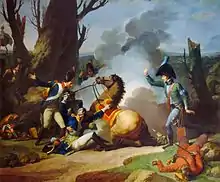Jean-Marie Valhubert
Jean-Marie Mellon Roger, better known as le général Valhubert, was born on October 22, 1764, at Avranches in Normandy, and died December 3, 1805 at Brünn. He was a French General during the French Revolution.
Jean-Marie Mellon Roger | |
|---|---|
 | |
| Born | October 22, 1764 Avranches, Manche |
| Died | December 3, 1805 (aged 41) Battle of Austerlitz, Austria |
| Occupation | General |
Before he attained twenty years of age, he enrolled in the Rohan-Soubise Regiment. During the beginning of the French Revolution, he returned to his family.
In 1791, the first battalion of the Manche, elected him as their leader on October 22. He conducted this battalion, which was attached to the Northern Army, with which he conducted his military campaigns in 1792 and 1793.
As superior officer, he was noticed in Lille, in Anvers, and in Lawfeld; was made a prisoner of war in Quesnoy September 13, 1793, and was brought to Hungary. He was exchanged during year IV of the French Republican Calendar, and served in the inferior army until its suppression, but remained in Paris, from the month of vendémiaire of year V to the 30th of germinal, year VII, as leader of the half-brigade during the Battle of Montebello (1800).

In 1805, during the Battle of Austerlitz, which was commanded by Suchet, he had his leg fractured by a shell. He fell and was incapable of getting up until soldiers came to get him.[1] He died of his wounds five days later after this battle, where he had remained at his post with the fractured leg. His comrades erected a monument for him in the plains of Moravia. The Emperor Napoleon accomplished his last wishes after his death. He took charge of the family of the General, and ordered that a monument be erected in his name where he was wounded; that a new square in Paris be given his name; and that a marble statue be erected. Charles X gave the statue to his native city in 1828, and inaugurated in Avranches on September 16, 1832.[2]
His name is inscribed at the Arc de Triomphe, and on a tables of brass at the Galerie des batailles at the château de Versailles.
Notes
- « Souvenez-vous de l’ordre du jour (Dans l’ordre du jour donné avant la bataille, Napoléon avait défendu aux soldats de quitter leurs rangs sous le prétexte d’emmener les blessés), leur dit-il, reprenez vos rangs : si vous êtes vainqueurs, vous m’enlèverez d’ici ; si vous êtes vaincus, que m’importe un reste de vie ! – On lut bientôt dans le 33e bulletin, daté d’Austerlitz, le 16 frimaire : – « Le général Roger Valhubert est mort des suites de ses blessures. Il a écrit à l’Empereur une heure avant de mourir : « J’aurais voulu faire plus pour vous ; je meurs dans une heure ; je ne regrette pas la vie, puisque j’ai participé à une victoire qui vous assure un règne heureux. Quand vous penserez aux braves qui vous étaient dévoués, pensez à ma mémoire. Il me suffit de vous dire que j’ai une famille, je n’ai pas besoin de vous la recommander. »
- Histoire de la statue dans l'annuaire du Département de la Manche de 1833
References
 Bouillet, Marie-Nicolas; Chassang, Alexis, eds. (1878). Dictionnaire Bouillet (in French). Missing or empty
Bouillet, Marie-Nicolas; Chassang, Alexis, eds. (1878). Dictionnaire Bouillet (in French). Missing or empty |title=(help)- Mullié, Charles (1852). . (in French).
